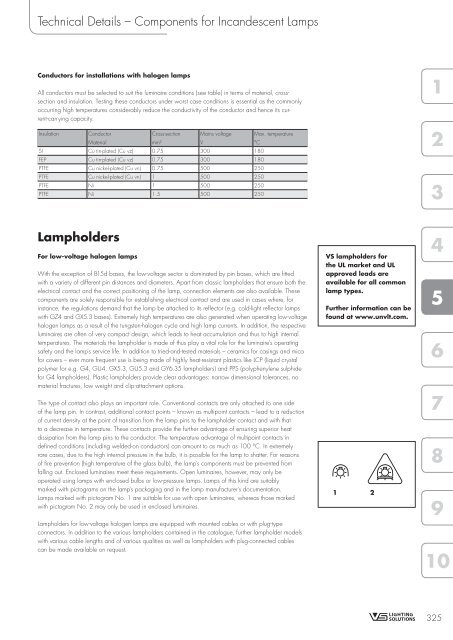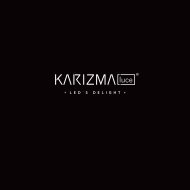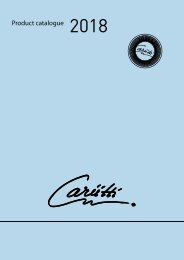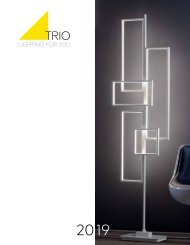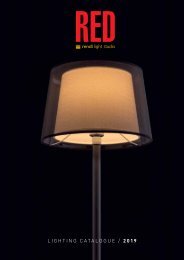VS_2017
You also want an ePaper? Increase the reach of your titles
YUMPU automatically turns print PDFs into web optimized ePapers that Google loves.
Technical Details – Components for Incandescent Lamps<br />
Conductors for installations with halogen lamps<br />
All conductors must be selected to suit the luminaire conditions (see table) in terms of material, crosssection<br />
and insulation. Testing these conductors under worst case conditions is essential as the commonly<br />
occurring high temperatures considerably reduce the conductivity of the conductor and hence its current-carrying<br />
capacity.<br />
Insulation Conductor Cross-section Mains voltage Max. temperature<br />
Material mm² V °C<br />
SI Cu tin-plated (Cu vz) 0.75 300 180<br />
FEP Cu tin-plated (Cu vz) 0.75 300 180<br />
PTFE Cu nickel-plated (Cu vn) 0.75 500 250<br />
PTFE Cu nickel-plated (Cu vn) 1 500 250<br />
PTFE Ni 1 500 250<br />
PTFE Ni 1.5 500 250<br />
1<br />
2<br />
3<br />
Lampholders<br />
For low-voltage halogen lamps<br />
With the exception of B15d bases, the low-voltage sector is dominated by pin bases, which are fitted<br />
with a variety of different pin distances and diameters. Apart from classic lampholders that ensure both the<br />
electrical contact and the correct positioning of the lamp, connection elements are also available. These<br />
components are solely responsible for establishing electrical contact and are used in cases where, for<br />
instance, the regulations demand that the lamp be attached to its reflector (e.g. cold-light reflector lamps<br />
with GZ4 and GX5.3 bases). Extremely high temperatures are also generated when operating low-voltage<br />
halogen lamps as a result of the tungsten-halogen cycle and high lamp currents. In addition, the respective<br />
luminaires are often of very compact design, which leads to heat accumulation and thus to high internal<br />
temperatures. The materials the lampholder is made of thus play a vital role for the luminaire's operating<br />
safety and the lamp's service life. In addition to tried-and-tested materials – ceramics for casings and mica<br />
for covers – ever more frequent use is being made of highly heat-resistant plastics like LCP (liquid crystal<br />
polymer for e.g. G4, GU4, GX5.3, GU5.3 and GY6.35 lampholders) and PPS (polyphenylene sulphide<br />
for G4 lampholders). Plastic lampholders provide clear advantages: narrow dimensional tolerances, no<br />
material fractures, low weight and clip-attachment options.<br />
The type of contact also plays an important role. Conventional contacts are only attached to one side<br />
of the lamp pin. In contrast, additional contact points – known as multipoint contacts – lead to a reduction<br />
of current density at the point of transition from the lamp pins to the lampholder contact and with that<br />
to a decrease in temperature. These contacts provide the further advantage of ensuring superior heat<br />
dissipation from the lamp pins to the conductor. The temperature advantage of multipoint contacts in<br />
defined conditions (including welded-on conductors) can amount to as much as 100 °C. In extremely<br />
rare cases, due to the high internal pressure in the bulb, it is possible for the lamp to shatter. For reasons<br />
of fire prevention (high temperature of the glass bulb), the lamp's components must be prevented from<br />
falling out. Enclosed luminaires meet these requirements. Open luminaires, however, may only be<br />
operated using lamps with enclosed bulbs or low-pressure lamps. Lamps of this kind are suitably<br />
marked with pictograms on the lamp's packaging and in the lamp manufacturer's documentation.<br />
Lamps marked with pictogram No. 1 are suitable for use with open luminaires, whereas those marked<br />
with pictogram No. 2 may only be used in enclosed luminaires.<br />
Lampholders for low-voltage halogen lamps are equipped with mounted cables or with plug-type<br />
connectors. In addition to the various lampholders contained in the catalogue, further lampholder models<br />
with various cable lengths and of various qualities as well as lampholders with plug-connected cables<br />
can be made available on request.<br />
<strong>VS</strong> lampholders for<br />
the UL market and UL<br />
approved leads are<br />
available for all common<br />
lamp types.<br />
Further information can be<br />
found at www.unvlt.com.<br />
4<br />
5<br />
6<br />
7<br />
8<br />
9<br />
10<br />
325


